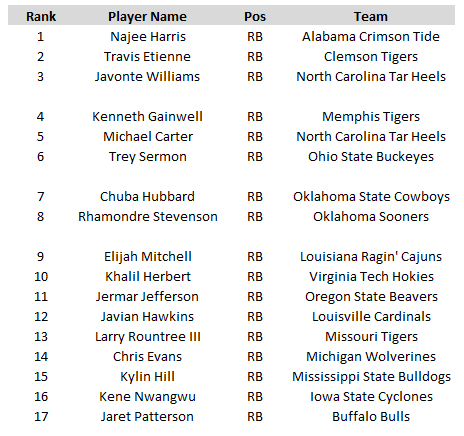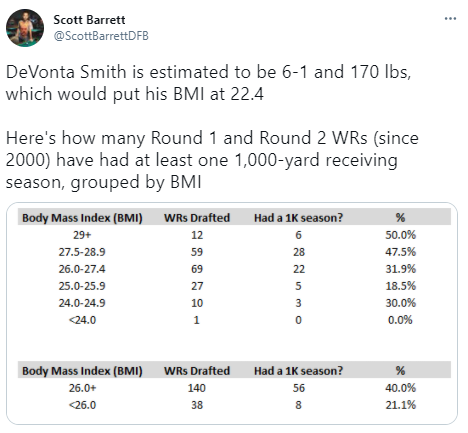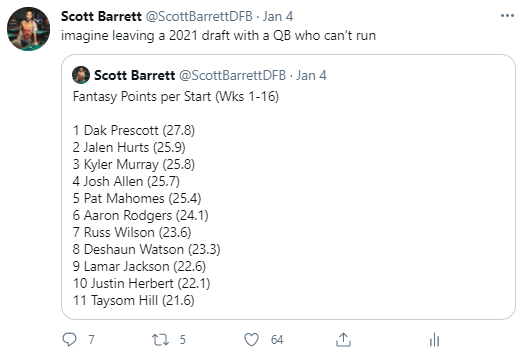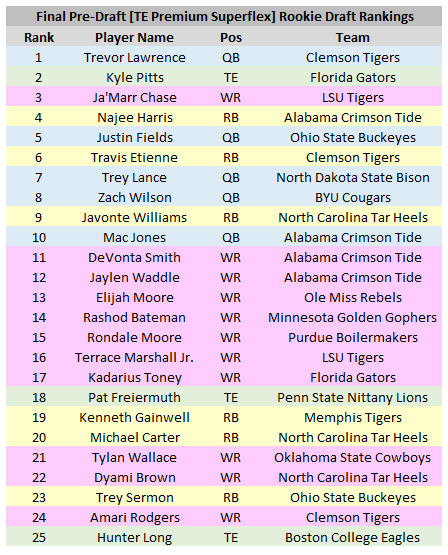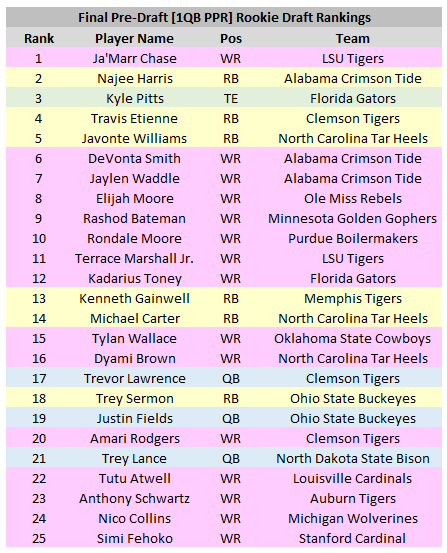In yesterday’s article we asked the question, “How much does athleticism matter?” The answer to that question was somewhere around 2,500 words long, but in short, athleticism is pretty overrated from a fantasy perspective. That said, it’s also far from irrelevant. It’s a piece of the puzzle. Athleticism alone can get you drafted, but it’s probably not enough on its own to bring you to fantasy relevance.
The far majority of RBs, WRs, and TEs who posted a great production score in college and a great athleticism score at the Combine were great players for fantasy. Players with poor scores by both production and athleticism almost never did anything meaningful for fantasy teams. Players with one or the other (with production mattering more than athleticism) were somewhere in between.
I concluded the article saying basically this. But also that my new stat – SPORQ score – is the best tool you could use to measure athleticism. You can find that stat and our historical Combine database here.
In today’s article we’ll be breaking down the 2021 class by SPORQ score. Where did these players rank in Phase I of my model (something akin to a composite production and efficiency score)? Where do they rank by SPORQ score (something akin to a composite athleticism score)? Where do they rank now in my finalized Pre-Draft Rookie Rankings? Who moved up or down my board the most? Who has the most serious red flags? Who are some hyper-athletic sleepers we might have missed in our first series of articles? We’ll answer each of those questions in today’s article.
Note 1: Big shoutout to the great Dane Brugler and his 2021 NFL Draft Guide, which you can find here. He, alongside a few other of the industry’s best talent evaluators and NFL Draft prognosticators, played a key role in helping me calculate an important but ultimately minor variable in this phase of the process – expected draft capital. His Pro Day info was critical, as well, pulling those numbers directly from NFL teams. That’s about as official as these numbers are going to get this year.
Note 2: Much is made over the fact that Pro Day numbers are typically much better than the numbers that same player will post at the Combine. I found this article very compelling, arguing that we should not adjust or devalue a player’s 2021’s Pro Day numbers. If you disagree, that’s fine and I totally understand the logic there. But I kept these numbers the same partly because you can adjust them from here on your own if you so choose.
Important SPORQ Thresholds
Running Backs
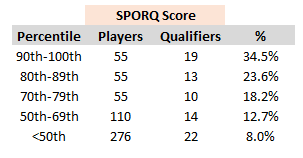
Wide Receivers
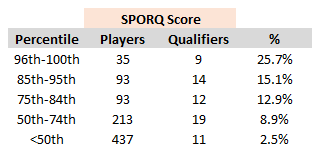
Tight Ends

Historical Player Comps
Here’s a twitter thread looking at some historical player comparisons for the 2021 class based on athletic profile. Just note, I was primarily shooting for only the most favorable comparisons in each instance.
Running Backs
I urge you to review my Pre-Combine rankings and analysis, which you can read here.
2021 Class by SPORQ Score 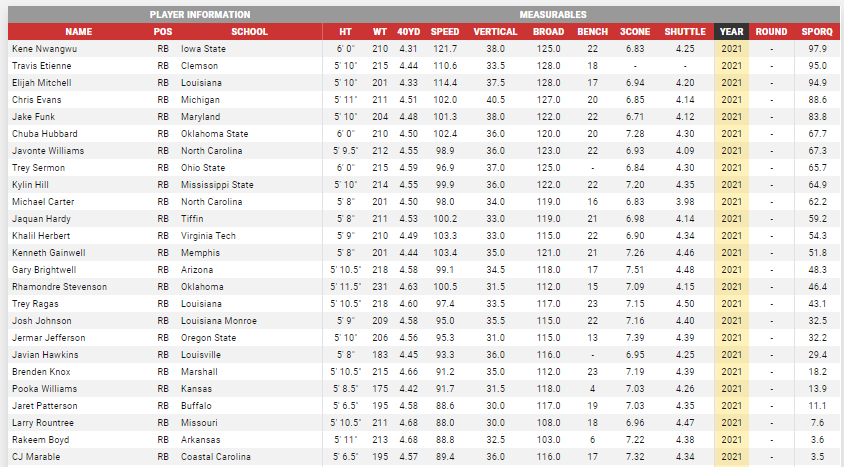
You can find this chart here, along with where all of these players rank since 2000.
Finalized Dynasty Rookie Rankings (Tiered)
Historical Marks
Elijah Mitchell ran a 4.33 40-yard-dash at his Pro Day. Since 2000, we’ve only ever seen two RBs record a faster time at the Combine: Chris Johnson (4.24) and Keith Marshall (4.31).
Remarkably, Kene Nwangwu actually bested Mitchell’s mark with a 4.31 40-yard-dash. This would rank tied with Marshall for 2nd-best since 2000.
At 210 pounds, Kene Nwangwu’s 121.71 Speed Score ranks best in this class and 15th-best since 2000, just ahead of Jonathan Taylor (121.70).
Chris Evans’ 167.5 burst score ranks best in this class and 17th-best since 2000. Elijah Mitchell isn’t too far behind (165.5), ranking 27th-best since 2000.
Chris Evans’ vert jump of 40.5” ranks 15th-best since 2000.
Elijah Mitchell and Travis Etienne both posted a broad jump of 128”, which ranks 22nd-best since 2000.
Jake Funk’s 6.71 3-Cone ranks 13th-best since 2000, and, if weight-adjusted, 15th-best since 2000.
Michael Carter’s 3.98 short shuttle ranks 8th-best since 2000.
Red Flags (Death Knell)
Demetric Felton (ADP: RB15) posted a 1.3 SPORQ score. That ranks 9th-worst of 598 qualifiers since 2000.
Rakeem Boyd (ADP: RB20) posted a 3.6 SPORQ score.
Larry Rountree (ADP: RB17) posted a 7.6 SPORQ score.
Jaret Patterson (ADP: RB11) posted a 11.1 SPORQ score.
Pooka Williams (ADP: RB16) posted a 13.9 SPORQ score. Williams was heavily penalized due to his low weight, at only 175 pounds (with a height of 5’ 8.5”). Since 1995, the only sub-180-pound RB to hit triple-digit fantasy points in a single season is Dexter McCluster, who accomplished this feat only once. Several other RBs, including Patterson, Felton, and Javian Hawkins, among others, were also penalized due to a low playing weight, but none quite on the level of Williams.
Boyd, Felton, and Williams are now fully off my board. Rountree dropped outside of my top-10 (RB13) and Patterson was pushed outside of my top-15 (RB17).
Red Flags (Less Severe)
Javian Hawkins (ADP: RB13), my pre-Combine RB7, posted a 29.4 SPORQ score.
Jermar Jefferson (ADP: RB6), my Pre-Combine RB6, posted a 32.2 SPORQ score.
Rhamondre Stevenson (ADP: RB10) posted a 46.4 SPORQ score.
Although my Pre-Combine model liked Hawkins and Jefferson quite a bit, both fell in this phase of the process. Stevenson, who I liked even more than my model did, also fell, but not as far. He isn’t quite as unathletic as the other two, and he has better expected draft capital (RB7, Round 4) than either RB.
Green Flags (Is that the opposite of a red flag?)
Looking back at my top-5 RBs, all except Najee Harris (DNQ) hit the necessary thresholds to retain their rankings. Travis Etienne (95.0) actually deserves a significant boost up my rankings. Although he’s still RB2 behind Harris in my personal rankings, that gap is now slightly closer, and Etienne looks much more like the truly “special” RB prospect I thought he would be.
Javonte Williams (67.3), Kenneth Gainwell (51.8), and Michael Carter (62.2) all retain their rankings, though Gainwell’s score was a bit underwhelming. He was dinged partly due to size (5’8”, 201 pounds), but also for a pedestrian 3-Cone – an event which matters a great deal more for smaller RBs. His 7.26 3-Cone ranks 6th-slowest in this class, and is significantly slower than (for instance) Trey Sermon’s time (6.84), even though Sermon is 14 pounds heavier. The 4.44 40-yard-dash helped make up some ground, but he still profiles as only an “average” athlete for the position.
After a strong Pro Day showing from Sermon (65.7), we can now view the RBs within two tiers. There’s the Big 3, consisting of Harris, Etienne, and Williams. And then a far less-exciting Little 3, consisting of Gainwell, Carter, and Sermon. Wes Huber has long been pounding the table for Sermon, and this was exactly what we needed to see from him in order to break into that second tier. The Big 3 RBs are all deserving of Round 1 picks in TE Premium Superflex Rookie Drafts. And then there’s a big tier fall-off — the “Little 3” should all be selected within the mid-Round 2 to early-Round 3 range. And then there’s another big tier drop, where everyone after that 2nd tier is even more uninspiring and unexciting.
Elijah Mitchell skyrocketed up my ranking with an elite SPORQ score (94.9). In this class, he ranks behind only Kene Nwangwu and Travis Etienne by SPORQ score, and he now sits at RB9 in my rankings. Stuck in a RBBC at Louisiana, my Pre-Combine model didn’t love his lack of production or the fact that he’s from a small school, but he flashed in a number of important efficiency metrics. For instance, last season, he ranked top-7 in both missed tackles forced per touch (0.30) and yards after contact per attempt (4.04). And in neither instance were those career-high marks.
Sleepers
Kene Nwangwu (ADP: UDFA) posted an elite 97.9 SPORQ score, which ranks 13th-best of 606 qualifiers since 2000. Chris Evans (ADP: RB18) wasn’t too far behind (88.6), and Jake Funk ranked right behind Evans (83.8).
Stuck behind David Montgomery and then Breece Hall at Iowa State, Nwangwu didn’t see very many touches (career-high 64 touches in 2020), but was efficient on those touches (5.2 career YPC). This probably means he’s not close to the prospect Montgomery was or that Hall is, but few are…
Evans, a former 4-star prospect, started in only six of 42 career games, and will be 24 years old as a rookie in 2021. He averaged 5.6 YPC across his career, but rarely ever touched the ball (only 25 times in 2020)…
In his fifth season at Maryland, after two ACL tears, Funk averaged 118.8 YFS per game on 14.0 touches per game in 2021…
Funk probably doesn’t get drafted, but Evans and (then) Nwangwu are expected to see their names called on Day 3. Don’t expect much, but at least one of these RBs will be drafted on athleticism alone and will be given a season or two to develop. Nwangwu and Evans might be worth a Round 5 dart throw in deep dynasty leagues.
It’s Complicated
Due to a minor ankle injury, Najee Harris didn’t workout at his Pro Day, and as such recorded a SPORQ score of DNQ (Did Not Qualify). Had he been fully healthy and simply elected not to participate, he might have fallen in my rankings, but I’m willing to accept this excuse and keep him ranked as the clear RB1 in this class.
And had he run, it’s possible Harris might look like an even better prospect than the one he already is (4th-best since 2015, per my Pre-Combine model). Reportedly, Harris has been clocked at 4.45 in the 40-yard-dash and 3.7 in the short shuttle. Both are elite times at his size (6’1”, 232 pounds). That would give Harris a 96th-percentile Speed Score at the position, and maybe the best ever short shuttle in Combine history at any position if he did in fact run a 3.70 shuttle – a truly unfathomable mark, let alone for a player his size. That said, I don’t think we should be trusting these numbers.
Wide Receivers
I urge you to review my Pre-Combine rankings and analysis, which you can read here.
2021 Class by SPORQ Score 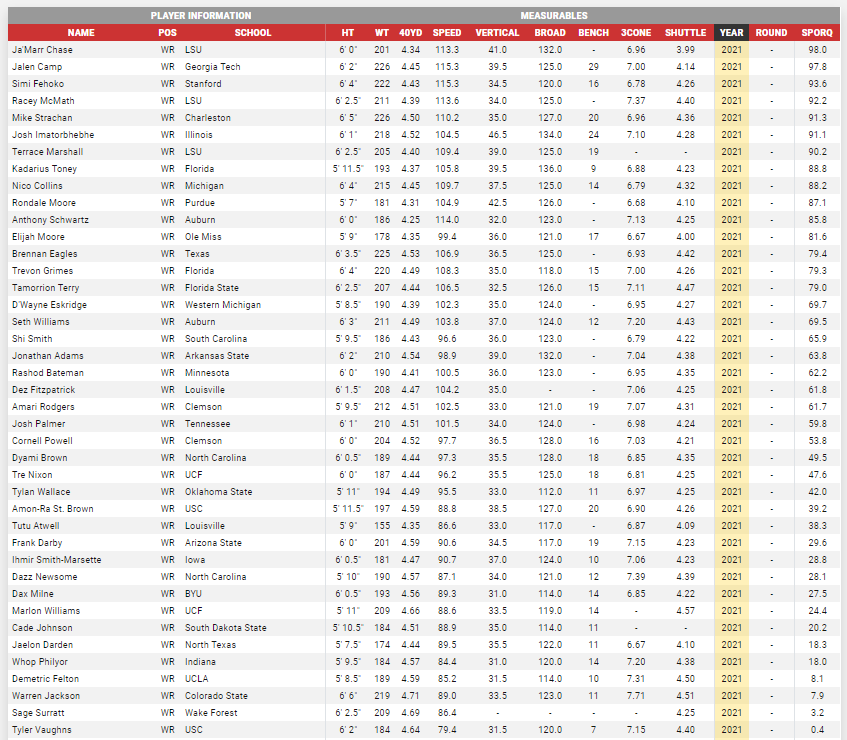
You can find this chart here, along with where all of these players rank since 2000.
Finalized Dynasty Rookie Rankings (Tiered) 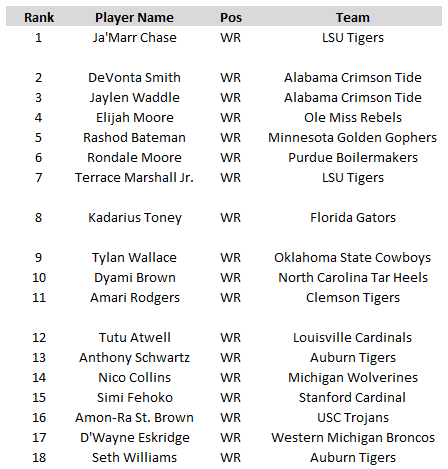
Historical Marks
Anthony Schwartz ran a 4.25 40-yard-dash at his Pro Day. Since 2000, only two WRs have recorded a better time at the NFL Combine: Donte Stallworth and John Ross, both at 4.22.
Rondale Moore’s 4.31 40-yard-dash ranks 13th-best since 2000. Ja’Marr Chase’s 4.34 ranks 37th-best since 2000 (96th percentile).
Simi Fehoko (115.3) and Jalen Camp (115.3) are two of only 46 WRs since 2000 to record a Speed Score of 115.0 or better.
Josh Imatorbhebhe’s 180.5 burst score ranks 5th-best since 2000. Kadarius Toney’s 175.5 ranks 11th-best. Chase’s 173.0 ranks 20th-best.
Imathorbhebhe’s 46.5-inch vert jump is a new record, and 1.5 inches more than the next-closest WR. Rondale Moore’s 42.5 ranks 11th-best.
Toney’s 136.0-inch broad jump ranks 6th-best since 2000. Not far behind is Imatorbhebhe (134.0, 14th-best), and then Chase (132.0, 23rd-best) and Jonathan Adams (132.0, 23rd-best).
Chase (3.99) is one of only 39 WRs to post a short shuttle time under 4.00. Elijah Moore just missed the mark (4.00).
Elijah Moore and Jaelon Darden both recorded a 3-Cone of 6.67, which ranks 45th-best since 2000. Rondale Moore’s 6.68 ranks 50th-best.
Jalen Camp’s 29 bench press reps are the most by any WR since 2000, and two more than the next-closest WR. Imatorbhebhe’s 24 bench reps rank 7th-most.
Red Flags (Death Knell)
Sage Surratt (ADP: WR20) posted a 3.2 SPORQ score.
Warren Jackson (ADP: WR:30) posted a 7.9 SPORQ score.
Demetric Felton (ADP: RB15), if listed as a WR, would have posted a 8.1 SPORQ score.
Jaelon Darden (ADP: WR19) posted a 18.3 SPORQ score.
Cade Johnson (ADP: WR28) posted a 20.2 SPORQ score.
Dazz Newsome (ADP: WR22) posted a 28.1 SPORQ score.
Frank Darby (ADP: WR26) posted a 29.6 SPORQ score.
All now rank outside of my top-20 WRs.
Red Flags (Less Severe)
Tutu Atwell (ADP: WR16) posted a 38.3 SPORQ score, dropping from 69.6 after being heavily penalized due to an anomalously low weight (155 pounds) and low BMI (22.9). Atwell ranked 8th in my Pre-Combine model, but I was certain he’d fall during this phase of the process.
Amon-Ra St. Brown (ADP: WR8) posted a 39.2 SPORQ score. Solid numbers in the jumps and the bench press were not enough to offset the pedestrian 40-time at his size (88.8 Speed Score).
Tylan Wallace (ADP: WR9) posted a 42.0 SPORQ score.
Dyami Brown (ADP: WR11) posted a 49.5 SPORQ score.
Brown’s middling SPORQ score was a little surprising to me. His 40-time (4.44), 3-Cone (6.85), and broad jump (128.0) were solid, but much less impressive at his size (97.3 Speed Score), and his lack of size (189 pounds, 25.2) surely played a role in his unexpectedly low score. Still, his production profile is strong enough that he didn’t at all fall in my rankings despite just missing the 50th percentile benchmark.
Brown was compared favorably to Stefon Diggs by Dane Brugler and was projected by Mel Kiper Jr. to be selected early in Round 2 (WR8). He's one of the rare outside WRs in this class, with 98% of his career receiving yards coming out wide. In North Carolina’s run heavy offense, Brown hit 1,000 receiving yards in back-to-back seasons with 20+ yards per reception in both years. He’s reached at least 50 yards in 20 of his 24 games over this span, and his 3.11 YPRR average in 2020 ranked 6th-best in this class.
The three other WRs all dropped in my rankings, but, interestingly, none fell too far. All have good projected draft capital behind them, and, interestingly, even Atwell. (So, maybe the NFL isn’t as concerned with his low weight as I am.) All four WRs are expected to be off the board by the end of Round 3.
Green Flags (Is that the opposite of a red flag?)
My Pre-Combine model viewed Ja’Marr Chase as the best WR prospect since at least 2015. After an elite showing at his Pro Day, recording a class-high 98.0 SPORQ score, I like Chase even more now, and I didn’t even think that could be possible. He needs to be viewed as an A.J. Green/Julio Jones level of prospect for fantasy.
Kadarius Toney (ADP: WR10) was one of the prospects my Pre-Combine model struggled with the most. However, his SPORQ score of 88.8 is highly encouraging, as is his projected draft capital (WR4, Round 1-2 per Dane Brugler). I now have him quite a bit higher than his ADP.
Terrace Marshall (ADP: WR6) was another big winner. He has good size (6’2”, 205 pounds) and his SPORQ score is near-elite (90.2). And he also has projected draft capital working in his favor (WR7, Round 2). He’s jumped from WR9 in my rankings to WR7.
Elijah Moore (ADP: WR7) has been knocked for his size (5’9”, 178 pounds), and that did hurt him somewhat in my model (falling from 88.4 to 81.6), but he also posted the best 3-Cone (6.67), the 2nd-best short shuttle (4.00), and the 4th-best 40 in this class (4.35), which is exactly what he needed to do to alleviate those concerns. For reference, Speed Score, 40-time, and the 3-Cone (in order) were the three most important events for shorter WRs.
My Pre-Combine model did not like Nico Collins (WR15), but he has ideal size (6-4 and 215 lbs) and good athleticism (88.2 SPORQ score). He’s one of the rare outside WRs in this class, with 100% of his career receiving yards coming out wide. The question is, is that all there is to like with Collins? Is that why he’s now expected to be drafted on Day 2? Saddled with poor QB-play, Collins didn’t do much in three seasons at Michigan, before sitting out in 2020, totaling just 78 catches, 1,388 yards, and 13 scores over this span. From 2018-2019, he led the team, averaging 54.4 receiving YPG, just ahead of sixth-round pick Donovan Peoples-Jones (same age), who averaged 43.8 YPG.
I’m still trying to figure out why my Pre-Combine model liked Anthony Schwartz so much (Pre-Combine WR11). Because if you add in the elite 40-time and the strong SPORQ score (85.8) in spite of the size concerns, he looks like an extremely high-level prospect. For one thing, he’s exceedingly young – the youngest WR in this class (age: 20.6). He was also an immediate starter and meaningful contributor for Auburn, totaling 117 YFS and two total touchdowns in his first game. He had turned 18 just three days prior. He ended that season totaling 568 yards from scrimmage and seven total touchdowns, which compared favorably to fourth-year junior Darius Slayton’s 670 yards and five touchdowns. However, a bulk of his production came on the ground. Last season, among all Power-5 WRs, he ranked behind only Jaylen Waddle in yards after the catch per reception (9.0).
Fellow Auburn WR Seth Williams’ SPORQ score was solid (69.5), but he jumped in my rankings primarily due to a miscalculation in Phase I of my model. He’s actually a full year younger than I thought he was. Williams (0.4 years older than Schwartz) averaged 64.3 YPG through three seasons at Auburn, compared to Schwartz’s 43.4 YPG. As a freshman in 2018 (age 18.4), he turned 47 targets into 534 yards and 5 scores. Darius Slayton (age 21.6) led the team, turning 72 targets into 670 receiving yards and 5 touchdowns.
Sleepers
Jalen Camp (97.8), Simi Fehoko (93.6), Racey McMath (92.2), Michael Strachan (91.3), and Josh Imatorbhebhe (91.1) all posted elite SPARQ scores.
Fehoko (6’4”, 222 pounds) is the most-exciting of the bunch (WR15 in my rankings). He led Stanford in receiving yards last season, recording over twice as many as the next-closest receiver (33.3% YMS). After averaging 62.9 YPG in 2019, he bumped that up to 95.7 in 2020. He’s old for a prospect (23.4), but his athleticism is undeniable. Among WRs, his 115.3 Speed Score ranks behind only D.K. Metcalf (12.97), Chase Claypool (124.7), and Jazz Ferguson (115.8) since 2016. There’s a chance Fehoko gets drafted on Day 2 (Mel Kiper Jr. has him going in Round 2), while Camp, McMath, Strachan, and Imatorbhebhe are all longshots to get drafted before Round 7, if at all…
Camp led Georgia Tech in receiving yards last year, averaging 46.3 YPG in their run-heavy offense (20.9% YMS). However, he’s 22.8 years old and never ranked higher than 4th on the team in receiving yards prior to last season…
McMath was a one-year starter for LSU, understandably buried in the depth chart behind some elite WRs. In 5 games in 2020, he caught 14 balls for 195 yards and 1 score. He’ll join a team in 2021, but it’s unlikely he ever contributes beyond special teams…
Strachan is the biggest WR in this class at 6’5” and 226 lbs but also one of the oldest (23.7). He’s a small school WR (Division II), hailing from the University of Charleston, which didn’t have a football season in 2020. In 2019, his redshirt junior-year, he averaged 7.1 receptions, 119.9 yards, and 1.73 touchdowns per game. For perspective, fellow Division II WRs Adam Thielen, Tyreek Hill, and John Brown never eclipsed 100.0 YPG in a single season…
Imatorbhebhe is a 23.0-year-old former 4-star recruit, who transferred to Illinois from USC after coming away with just two catches in three injury-plagued seasons. He led Illinois in receiving in both 2019 and 2020, recording yardage share numbers of (adjusting for missed games) 32.5% (2019) and 26.9% (2020)…
It’s Complicated
Rondale Moore was heavily penalized due to his short stature (5’7”), but helped make up some ground with some absurd numbers in the 40, Vert, 3-Cone, and Shuttle. His SPORQ score of 87.1 ranks 11th-best in the class. Prior to the height-based adjustment, he ranked 6th-best. Like I said, Moore was penalized due to his height, but whatever reduction I gave him (via SPORQ score) was always going to be wholly arbitrary. Ultimately his small stature and miniature catch radius is a major red flag, but it’s hard to quantify exactly how damning of a red flag it is. Since 2000, there have been only two WRs listed at 5’7” or shorter to record at least one season of 600 receiving yards or more: Taylor Gabriel and Andrew Hawkins. Both players went undrafted. Since 2000, we’ve never seen a WR listed at 5’7” or shorter get drafted before Round 4, and those who were drafted (at all) were never meaningful contributors for fantasy. At 5’8”, the numbers don’t look much better either, with Cole Beasley being the most productive fantasy WR from that grouping.
Neither DeVonta Smith nor Jaylen Waddle participated in their workouts at the Alabama Pro Day. Waddle is still recovering from the injury (a high ankle sprain plus fracture, which required surgery) that caused him to miss a bulk of the 2020 season. But we already know he’s a high-level (probably elite) athlete. For instance, here is a video of Waddle racing speedster Henry Ruggs in the 40 (which resulted in a tie). He reportedly ran a 4.37 40-yard dash at the UA Houston Camp in 2017. Although officially listed with a DNQ SPORQ score, I actually boosted Waddle in my rankings. (We already know he’s a freak athlete, and he’s a Round 1 lock based on expected draft capital.)
DeVonta Smith on the other hand… Smith elected not to workout at Alabama’s Pro Day. Unlike with Harris and Waddle, this was not because of a pre-existing injury, this was by choice. The implication here is that Smith was worried a lackluster showing might have hurt his draft stock, which is to say a lackluster showing was somewhere between possible and probable. Last year, Tyler Johnson (whom my Pre-Combine model loved) elected not to participate in any event at the Combine. I severely penalized him for that fact and that appeared to be the right move – my Pre-Combine model said he was deserving of a Round 1 or Round 2 pick, but he was ultimately drafted in Round 5.
Worse yet, Smith is listed at 6’0” and 170 pounds. That’s also a major red flag. Since 2000, the only WR to weigh 175 pounds or less and post a 1,000-yard season is DeSean Jackson (169 pounds). And Smith surely does not have Jackson’s 4.35 wheels. The low BMI (23.1) is also a concern. Jackson (24.2 BMI) is also the only WR to post a BMI below 24.5 and record a 1,000-yard season. And Smith’s BMI is the 9th-lowest by any Combine WR since at least 2000, while Jackson ranks 40th-lowest.
Ultimately, I have no choice but to penalize Smith, though whatever I decide to go with (a 15% reduction, a 25% reduction?) is going to be wholly arbitrary. And again, athleticism doesn’t matter anywhere near as much as college production, and Smith’s numbers were off the charts in that regard. So this put me in a tricky situation. Smith still ranks quite high by projected draft capital (WR3, Round 1), so the NFL doesn’t seem to be as concerned with Smith’s athleticism as they (presumably) were with Tyler Johnson’s. At the end of the day, Smith dropped a tier in my overall rankings but still ranks as my WR2 in this class.
All of the size-related concerns with Smith are an even bigger issue for Tutu Atwell (5’9”, 155 pounds, 22.9 BMI).
Tight Ends
I urge you to review my Pre-Combine rankings and analysis, which you can read here.
2021 Class by SPORQ Score 
You can find this chart here, along with where all of these players rank since 2000.
Finalized Dynasty Rookie Rankings (Tiered) 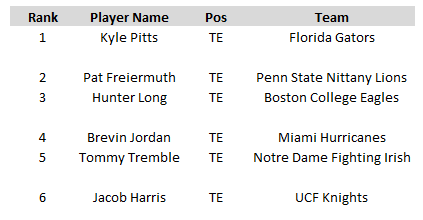
Historical Marks
Kyle Pitts and Jacob Harris both ran a 4.40 40-yard-dash at their respective Pro Days. Since 2000, only one TE has ever recorded a faster time at the NFL Combine (Vernon Davis, 4.38). By Speed Score Pitts’ 130.7 ranks 2nd-best (behind Davis), while Harris moves to 29th-best since 2000.
Harris’ 6.51 3-Cone is the best mark ever recorded by a TE, and would rank 2nd-best among RBs (just ahead of Christian McCaffrey) and 7th-best among WRs. If weight-adjusted, he ranks 2nd-best among TEs since 2000.
John Bates’ weight-adjusted 3-Cone ranks 22nd-best since 2000.
Ben Mason’s 29 bench press reps ranks 9th-most since 2000.
Jacob Harris’ 173.5 burst score ranks best ever by a TE, and would rank 17th-best among WRs. That’s tied with Julio Jones and 1.0 less than D.K. Metcalf. Among TEs, Harris also ranks 2nd-best since 2000 in the broad jump and 6th-best in the vert.
Pitts’ 129.0 broad jump ranks 8th-best since 2000. He ranks 17th-best in burst score (162.5), five spots ahead of Briley Moore (160.5).
Red Flags (Death Knell)
- We mentioned Tony Poljan as a potential deep sleeper after he ranked 7th-best in the class in our Pre-Combine model. I wrote, “Poljan isn’t worth drafting without an elite Pro Day showing or high-end (NFL) draft capital behind him, but remains a player to monitor long-term.” And well, that Pro Day showing was far from elite. He posted a 25.6 SPORQ score (2nd-worst in the class), and is now fully off my radar.
Red Flags (Less Severe)
- Brevin Jordan posted a sub-70th-percentile SPORQ score (54.1), while Hunter Long (70.4) just made the cutoff. 23% of the players above that threshold had at least one top-6 fantasy season across their careers, as opposed to just 10% for all players falling beneath that threshold. This was enough for me to move Jordan to TE4 in my rankings, behind Pitts, Pat Freiermuth, and Long, who, by the way, is looking like a legitimate Mark Andrews clone. Don’t forget what we talked about yesterday – athleticism matters more for TEs than for RBs or WRs.
Green Flags (Is that the opposite of a red flag?)
Kyle Pitts. Man, what an absolute freak of nature. According to my Pre-Combine Model, Pitts is the best TE prospect to come out since at least 2014, and maybe the best TE prospect ever. From an athletic-standpoint, only Vernon Davis ranks higher by SPORQ (of 375 qualifiers since 2000). I didn’t think it was possible, but I like Pitts even more now than I did several weeks ago.
Tommy Tremble was missing from our Pre-Combine top-7. Lance Zierlein actually has him ranked as the 2nd-best TE in the class. Tremble has decent size (at 6’3”, 241 pounds) and is easily the best run blocker in this class, but he’s also a player every production model is going to miss on. In fact, after failing to reach 20 catches in either of his two seasons, he didn’t even meet the prerequisite thresholds to qualify for my Pre-Combine model. If Tremble is going to find fantasy success at the next level, he’s going to have to be an outlier in the same way Drew Sample and George Kittle were (in college both were A+ blockers without much usage in the passing game). Is he more Sample (68.0) or Kittle (94.9)? Tremble is fairly athletic, posting a 76.3 SPORQ score, but isn’t quite on Kittle’s level. But he does have projected draft capital on his side (Dane Brugler is projecting Round 2 or Round 3). He’s now my TE5, within the same tier as Jordan.
Sleepers 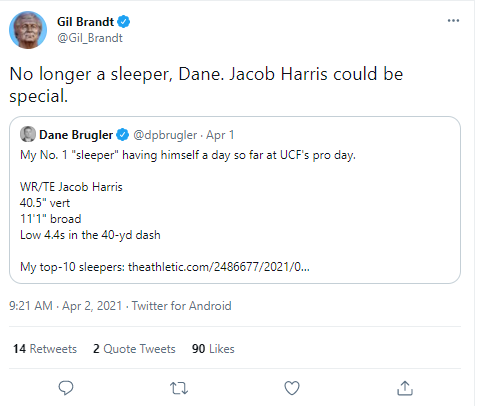
Jacob Harris ranks 7th-best in SPORQ score since 2000 (98.1), behind only Vernon Davis, Kyle Pitts, Rob Housler, Jimmy Graham, Noah Fant, and Evan Engram. If we called him a WR, he’d lead this class and rank 10th-best since 2000 (99.0).
His numbers are absolutely absurd, but he’s also fairly light for a TE. He’s 15 pounds lighter than Engram, who is the lightest TE in our database with at least one TE1 season. I could have penalized him for this fact but chose not to – weight actually has a slightly negative correlation to fantasy production for TEs. And that makes sense — the closer a player is to a WR, the better for fantasy (like we explained in our Pre-Combine analysis on Kyle Pitts).
Harris is pretty old as a prospect (Age: 24.0), and his production score was fairly underwhelming and especially so within that context. He ranked 3rd on his team in receiving yards last year, catching 30 balls for 539 yards and 8 scores. Over the past two seasons, he dropped 18% of his catchable targets, compared to 5% for Pitts. Basically, Harris is a rich man’s Jeff Janis. He’s going to be drafted on Day 3; a team will take a flier on him for his athleticism, but he’s a longshot to ever return meaningful fantasy production. Still, he ranks as my TE6 in this class, and I’d consider taking him in Round 5 of a TE Premium Superflex rookie draft on the off chance he’s the next Robert Tonyan.
It’s Complicated
Pat Freiermuth elected not to participate in the position drills at his Pro Day, as he’s still recovering from a shoulder injury. I’ll typically penalize a player for not participating in their Pro Day, but the shoulder injury is a legitimate concern (causing him to miss five games last year), so I chose not to in this instance. I have Friermuth ranked as my TE2 in this class in a tier alongside Long.
Kenny Yeboah strained his hamstring on his 40-yard-dash run, so I have him listed as a DNQ (Did Not Qualify). Like with Freiermuth, I’m not going to penalize him, but he did drop in my rankings due to projected draft capital. Dane Brugler is projecting him to be drafted in Round 6, a full round later than Harris.
Quarterbacks
Finalized Dynasty Rookie Rankings (Tiered) 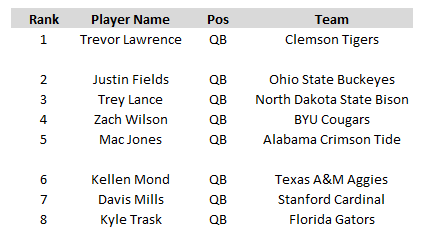
Thoughts
Athleticism isn’t super important for QBs outside of what it means for their Konami Code-potential, but that can be a massive factor.
Trey Lance averaged 13.3 rushing FPG and 77.0 rushing YPG across his college career at North Dakota State.
Justin Fields averaged 10.2 rushing FPG and 64.6 rushing YPG in 2020, after averaging 9.2 and 49.1 in 2019.
Trevor Lawrence averaged 8.1 rushing FPG and 39.9 rushing YPG over his last two seasons at Clemson.
Zach Wilson averaged 38.4 (2018), then 33.7 (2019), and then 29.4 (2020) rushing YPG in each of his three seasons at BYU. He averaged 7.9 rushing FPG in 2020 after averaging 5.3 rushing FPG across his first two seasons.
Mac Jones averaged 1.1 rushing FPG in 2020.
For perspective, in their best collegiate seasons, Lamar Jackson averaged 24.2 rushing FPG, Taysom Hill averaged 19.8, Jalen Hurts averaged 18.7, Kyler Murray averaged 12.8, Josh Allen averaged 8.1, and Joe Burrow averaged 7.6.
Of the likely Round 1 QBs in 2021, Mac Jones (4.82) and Justin Fields (4.46) were the only ones to run the 40-yard-dash at their Pro Day. At 227 pounds, Fields’ Speed Score of 114.74 ranks 3rd-best of 372-qualifying QBs since 2000. He ranks behind Robert Griffin III (126.9) and Michael Vick (119.5), and just ahead of Cam Newton (114.72) and Vince Young (113.7). By raw 40-yard-dash, he ranks behind only Griffin (4.33), Michael Vick (4.33), and Reggie McNeal (4.40).
Yeah, so, uhhh…. He’s a freak. You’re not fading that. Although Zach Wilson is a near-lock to be drafted second overall (and maybe even Mac Jones third overall), I have Fields right behind Lawrence as the QB2 in this class.
Trey Lance didn’t participate in any of the position drills at his Pro Day, but if you wanted to make a similar argument with him, I wouldn’t fault you for doing so.


